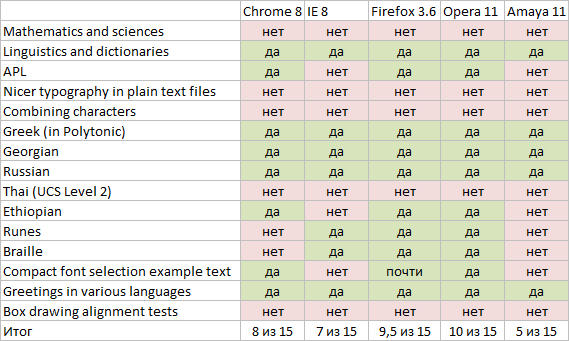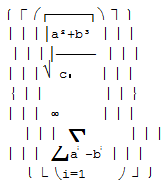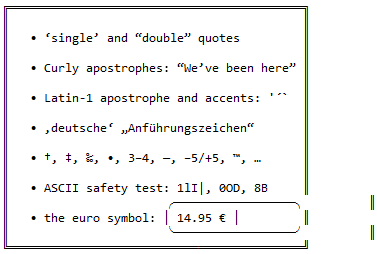UTF-8 Support Test
Recently I came across the following text file: link (if the site does not stand up, look for it ) by Dr Markus Kuhn from Cambridge. In essence, this is just text in UTF-8 encoding, but the whole point is that it contains various encoding features, like combining characters . As you will see, even "plain text" browsers display here and there in different ways and in some places they do not display at all. Test summary table for some well-known names (under Windows 7 64-bit, default fonts):

It is worth noting that in Chrome, Firefox, IE Courier New is the default monospaced font, Opera is Consolas.
')
Chrome did not find some of the characters and replaced them with squares. IE found everything, but issued

Firefox and Opera, too, found everything, but rendered even worse. Amaya found practically nothing.

No complaints to all participants.

Apparently, the author had in mind the programming language APL . Squares were not at Chrome, Firefox and Opera.

Only Opera was able to show round quotes (curly apostrophes) correctly. The rest did not cope. However, problems near the lower right corner of the frame arose in all.

The idea is that the characters are grouped instead of drawn one by one. In general, not yet drawn. It should be noted that Opera almost succeeded - only the vector sign did not succumb.

With browsers in Greek, Georgian and Russian, everything is in order.

The characters themselves found all browsers. However, the bottom says that with correct drawing there should be two even columns. This is not happening.

IE and Amaya did not find the Ethiopian language.

These ancient runes! It is a pity that Chrome and Amaya did not find the corresponding font.

Braille . Similar to the previous test.

IE and Amaya did not find some characters and replaced them with squares. Firefox in an odd way indented the penultimate line.

All browsers coped with this test.
Chrome

Internet Explorer

Firefox

Opera

Amaya

I included Amaya 11 in testing, because I thought that since this is the official W3C browser, then it should meet the specifications to the fullest extent. However, he showed the weakest result. Opera is deservedly the leader in the tests, but even she scored only two thirds of points. Although modern browsers support unicode and most languages, standards compliance is clearly lame. Of course, no one in real life will impose frames or round quotes in UTF-8, and this is not critical. However, in the pursuit of new HTML5 tags and Javascript performance, developers could pay more attention to rendering UTF-8 encoded text.

It is worth noting that in Chrome, Firefox, IE Courier New is the default monospaced font, Opera is Consolas.
Comments
')
Mathematics and sciences
Chrome did not find some of the characters and replaced them with squares. IE found everything, but issued

Firefox and Opera, too, found everything, but rendered even worse. Amaya found practically nothing.
Linguistics and dictionaries

No complaints to all participants.
APL

Apparently, the author had in mind the programming language APL . Squares were not at Chrome, Firefox and Opera.
Nicer typography in plain text files

Only Opera was able to show round quotes (curly apostrophes) correctly. The rest did not cope. However, problems near the lower right corner of the frame arose in all.
Combining characters

The idea is that the characters are grouped instead of drawn one by one. In general, not yet drawn. It should be noted that Opera almost succeeded - only the vector sign did not succumb.
Greek (in Polytonic), Georgian, Russian

With browsers in Greek, Georgian and Russian, everything is in order.
Thai (UCS Level 2)

The characters themselves found all browsers. However, the bottom says that with correct drawing there should be two even columns. This is not happening.
Ethiopian

IE and Amaya did not find the Ethiopian language.
Runes

These ancient runes! It is a pity that Chrome and Amaya did not find the corresponding font.
Braille

Braille . Similar to the previous test.
Compact font selection example text

IE and Amaya did not find some characters and replaced them with squares. Firefox in an odd way indented the penultimate line.
Greetings in various languages

All browsers coped with this test.
Box drawing alignment
Chrome

Internet Explorer

Firefox

Opera

Amaya

Summary
I included Amaya 11 in testing, because I thought that since this is the official W3C browser, then it should meet the specifications to the fullest extent. However, he showed the weakest result. Opera is deservedly the leader in the tests, but even she scored only two thirds of points. Although modern browsers support unicode and most languages, standards compliance is clearly lame. Of course, no one in real life will impose frames or round quotes in UTF-8, and this is not critical. However, in the pursuit of new HTML5 tags and Javascript performance, developers could pay more attention to rendering UTF-8 encoded text.
Source: https://habr.com/ru/post/110331/
All Articles